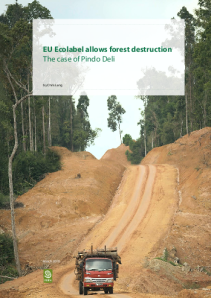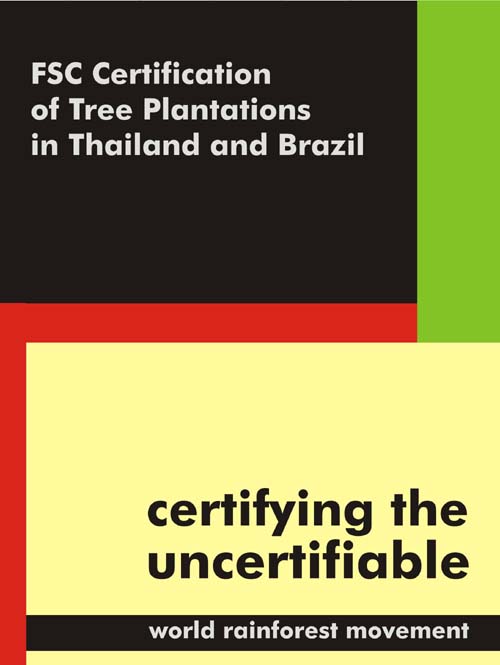Oji Paper has cleared large areas of forest in Laos to make way for its industrial tree plantations. Now the company hopes to get REDD funding for its monocultures.
By Chris Lang, WRM Bulletin 160, November 2010
In 2005, a Japanese company called Oji Paper took over a project to plant 50,000 hectares of mainly eucalyptus plantations in central Laos. The following year, as part of his research in Laos, a Canadian researcher took a series of photographs of forests cleared by Oji’s bulldozers. Now, Oji Paper wants to get REDD funding for its plantations in Laos.
The timing could not be better. Just weeks before Cancun, Oji Paper is demonstrating one of the most serious problems with the international discussions relating to REDD: the failure to differentiate between forests and plantations. Oji is also demonstrating how corporations can benefit from REDD while their operations have serious impacts on local livelihoods.
Oji Paper started another plantation project in Southern Laos earlier this year, covering a total of 30,000 hectares. The feasibility study, which starts this month and runs until March 2011, will look into potential REDD funding for Oji Paper’s plantations in central and southern Laos. The study is commissioned by Japan’s Ministry of Economy, Trade and Industry. It is supposed to develop, “the methods to measure, present and evaluate effectiveness of plantation projects in CO2 absorption and effectiveness of countermeasures against deforestation and forest degradation in reducing CO2 emissions,” according to an Oji Paper press release.[1]
Oji Paper plans to export wood chips from its plantations in Laos to feed its ever-expanding pulp and paper operations. It will be interesting to see how the feasibility study takes into account the fact that Oji Paper’s plantations will not store carbon for any length of time, but will be chipped, transported by road and sea and manufactured into paper. After use, much of this paper will be disposed of in landfills where it will rot and produce methane.
Oji Paper is one of the largest paper companies in the world, with a total of 240,000 hectares of plantations in Laos, Vietnam, China, Indonesia, Australia, New Zealand, Canada and Brazil. The company is planning a REDD programme and intends to apply the results of its feasibility study in Laos to its other plantations.
Between 2004 and 2006, Keith Barney, a researcher at York University, Toronto, carried out research in the village of Ban Pak Veng in Hinboun District in Laos. Barney described the village as suffering a “double displacement effect”, the first caused by being downstream of the recently constructed Theun Hinboun dam and the second by Oji’s plantations. “Through the land reform program,” Barney writes, “village degraded forests, which are crucial for village food security and swidden production, have been zoned for industrial plantation production and bulldozed.”
Oji’s concession area in central Laos covers a total area of 154,000 hectares, of which a total of 50,000 hectares is to planted. More than 55,000 people live inside this concession area.
In 2006, Oji commissioned the Global Environment Centre Foundation to carry out a feasibility study to investigate how Oji could gain carbon credits through the clean development mechanism (CDM). The report described villagers as carrying out “illegal slash-and-burn farming,” and noted that they have “no other means to secure food.”
Global Environment Centre Foundation’s report stated that “local inhabitants in the subject area continue to practice illegal slash-and-burn farming and the spontaneous recovery of the forest cannot occur due to the land degradation.”
As Barney pointed out, the report omitted to mention that villagers in Ban Pak Veng were “undertaking swidden farming not out of timeless tradition, but largely due to the loss of access to lowland paddy from the THPC [Theun Hinboun Power Company] hydropower project.”
Barney added that the CDM feasibility study “ignores at least twenty years of research in Laos on the importance of upland farming and swidden based non-timber forest products in the rural economy.” Barney documented in detail the complex relationship the villagers have with their land and forests and noted that the state officials, who are responsible for producing the maps for the land reform programme, “do not use anything like the same terms for landscape and forests as villagers do.”
Unfortunately we can expect the REDD feasibility study on Oji Paper’s plantations to make the same mistakes. It simply is not in the consultants’ interest to find out and document what is actually happening in rural Laos. Meanwhile it is in their interest to reduce complex social and environmental situations to simple questions of legality or illegality. They will also ignore local livelihoods. “As a result,” as Barney wrote about Oji Paper’s CDM plans, “a new set of livelihood risks are being pushed onto rural villagers in Laos, while the safety net of access to natural resources is removed from underneath them.”
In 2006, a villager said, “We have no land. Oji has taken it.” Another told Barney, “We are saying goodbye to our forests.”
If the company responsible for this destruction can now claim to be reducing emissions from deforestation and forest degradation, then the concept of REDD has become intellectually and morally bankrupt.
[1] Thanks to Mekong Watch for the translation from Japanese.










It seem to me that, i was working with you in Trang Bom Center in 1995 when i just graduated from University of Agriculture and Forestry in Ho Chi Minh City. This center was located in the southern of Vietnam.
Regards,
Khai Pham
pdkhai@gmail.com